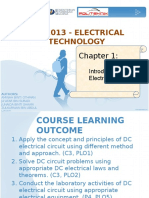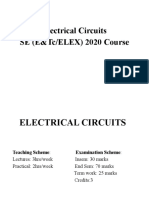Network Theorems
Network Theorems
Uploaded by
Sandeep SarmahCopyright:
Available Formats
Network Theorems
Network Theorems
Uploaded by
Sandeep SarmahOriginal Description:
Copyright
Available Formats
Share this document
Did you find this document useful?
Is this content inappropriate?
Copyright:
Available Formats
Network Theorems
Network Theorems
Uploaded by
Sandeep SarmahCopyright:
Available Formats
Course: EE 1101
Title: Basic Electrical Engineering
Module 3: Network Theorems
No in Sequence. 12
Unit: 3.1
Aim (s): Node & loop equations, Star delta conversions
Duration: 1 hour
Objectives:
At the end of this lecture students will be able to
1. State node and loop of any electrical network.
2. Write the node and loop equations of any electrical network.
3. State and apply voltage source to current source conversion and vice-versa.
4. Write the formulae of star to delta conversion and vice-versa.
5. Solve problems related to star delta conversion.
Evaluation:
1. What are node and loop in an electrical network?
2. Which circuit law(s) will apply to write node and loop equations of any electrical
network?
3. Write down the formulae of star to delta conversion of a resistive star network having
R1, R2 and R3 are the respective branch resistance.
4. Find the equivalent resistance between the terminals A and B.
See a note in the page of Sequence 16
Course: EE 1101
Title: Basic Electrical Engineering
Module 3: Network Theorems
No in Sequence.13
Unit: 3.2
Aim (s): Thevenin's Theorem (AC & DC),
Duration: 1 hour
Objectives:
At the end of this lecture students will be able to
1. State Thvenins theorem and explain basic idea behind it.
2. List the procedure for determining the Thvenin equivalence of an actual circuit from
the standpoint of two terminals.
3. Apply Thvenins Theorem to simplify a circuit for analysis.
Evaluation questions:
1. State Thevenins theorem.
2. Draw the Thevenins equivalent network.
3. To calculate Thevenins equivalent value in a circuit
(A) all independent voltage sources are opened and all independent current
sources are short circuited.
(B) both voltage and current sources are open circuited
(C) all voltage and current sources are shorted.
(D) all voltage sources are shorted while current sources are opened.
To calculate Thevenins equivalent impedance value in a circuit, all independent
voltage sources are shorted while all independent current sources are opened.
4. Using Thevenins theorem, find the current through 5 resistor as shown in the Fig.
See a note in the page of Sequence 16
Course: EE 1101
Title: Basic Electrical Engineering
Module 3: Network Theorems
No in Sequence. 14
Unit: 3.3
Aim (s): Norton's Theorem (AC & DC),
Duration: 1 hour
Objectives:
At the end of this lecture students will be able to
1. State Norton's Theorem and explain basic idea behind it.
2. List the procedure for determining the Norton's equivalence of an actual circuit from
the standpoint of two terminals.
3. Apply Norton's Theorem to simplify a circuit for analysis.
Evaluation questions:
1. State Norton's theorem
2. By using Nortons theorem, find the current in the load resistor RL for the circuit shown in
Fig. (Ans: IL=0.75 A)
See a note in the page of Sequence 16
Course: EE 1101
Title: Basic Electrical Engineering
Unit: 3.4
Module1 3: Network Theorems
Aim (s): Superposition Theorem (AC & DC),
Duration: 1 hour
Objectives:
At the end of this lecture students will be able to
1. State Superposition Theorem
2. Know the procedure to apply Superposition Theorem
3. Apply Superposition Theorem to simplify a circuit for analysis.
Evaluation questions:
1. What is superposition theorem?
2.
3.
4.
5.
6.
No in Sequence. 15
For what type of networks, superposition theorem is valid?
Is superposition theorem true for dependent sources?
Is superposition theorem true for powers as well? Why?
What is the practical use of superposition theorem?
Apply superposition theorem for the circuit shown in fig.
V1
R1
V2
R1
See a note in the page of Sequence 16
Course: EE 1101
Title: Basic Electrical Engineering
Module 3: Network Theorems
No in Sequence. 16
Unit: 3.5
Aim (s): Maximum power transfer theorem (DC),
Duration: 1 hour
Objectives:
At the end of this lecture students will be able to
1. State Maximum Power Transfer theorem for DC circuit.
2. Prove the statement of Maximum Power Transfer theorem for a DC circuit.
3. Apply the Maximum Power Transfer theorem to solve appropriate problems.
4. State the applications of Maximum Power Transfer theorem.
Evaluation:
1. State maximum power transfer theorem for DC circuit.
2. State power transfer efficiency.
3. Why MPT condition is not favourable in power system applications?
4. Why maximum power transfer theorem is applied to develop new circuit for known
applications?
5. States an application of maximum power transfer theorem.
6. State the MPT for AC circuits.
7. Find the value of RL for the given network below that the power is maximum. And
also find the maximum power through load-resistance RL by using maximum power
transfer theorem?
Note: Evaluation can also be done putting any numerical problem from tutorial sheet with an AC
circuit. But time will be short for the instructor to complete an AC problem to be solved in the class
after this discussion. Therefore, the capability of solving both AC and DC numerical problems using
maximum power transfer theorem may be elaborately solved or tested in the tutorial class.
You might also like
- 15-Module - 1 DC Circuits - Material, Question of Moudle 1 &2!19!09-2022Document5 pages15-Module - 1 DC Circuits - Material, Question of Moudle 1 &2!19!09-2022ManipriyaaNo ratings yet
- Det10013 CHPTR 2Document36 pagesDet10013 CHPTR 2Budak TbrNo ratings yet
- Ode Assignment FinalllDocument14 pagesOde Assignment FinalllM shayan JavedNo ratings yet
- Electrical Technology Topic 1 Sem 1 PoliteknikDocument118 pagesElectrical Technology Topic 1 Sem 1 Politeknikinjung89% (9)
- Mandatory Activity 12 - Week 6Document4 pagesMandatory Activity 12 - Week 6Arturo Del Rio100% (1)
- QB KEE101T ElectricalDocument15 pagesQB KEE101T Electricalplantforest16No ratings yet
- Chapters 1-2 in Deltoro: Nptel Module 1Document3 pagesChapters 1-2 in Deltoro: Nptel Module 1adityaNo ratings yet
- Bee Cse Course FileDocument12 pagesBee Cse Course FileJulie OsborneNo ratings yet
- Chapters 1-2 in Deltoro: Nptel Module 1Document3 pagesChapters 1-2 in Deltoro: Nptel Module 1adityaNo ratings yet
- SYLLABUSDocument2 pagesSYLLABUSNithin KumarNo ratings yet
- Electrical Technology 1st SemDocument20 pagesElectrical Technology 1st SemArslan Shani100% (1)
- Lab 7 STUDENT KIT LAB MODULEDocument8 pagesLab 7 STUDENT KIT LAB MODULEHidayat RusliNo ratings yet
- CB Lab Manual Cicrcuit LawsDocument13 pagesCB Lab Manual Cicrcuit LawsLin RongrongNo ratings yet
- American International University-Bangladesh: Department of Electrical and Electronic EngineeringDocument4 pagesAmerican International University-Bangladesh: Department of Electrical and Electronic EngineeringRuham RofiqueNo ratings yet
- Electric Circuit and Electronics NoteDocument34 pagesElectric Circuit and Electronics NoteEzekiel JamesNo ratings yet
- Software Engineering Lab MannualDocument17 pagesSoftware Engineering Lab MannualAmitKumarDasNo ratings yet
- Superposition TheoremDocument21 pagesSuperposition Theoremprasoon singhNo ratings yet
- Electric Circuit-1 Syllabus: Desert WarriorsDocument6 pagesElectric Circuit-1 Syllabus: Desert Warriorsapi-282583464No ratings yet
- N5ac36742044edll BookDocument27 pagesN5ac36742044edll Bookprtz.idNo ratings yet
- BEE New Important QuestionsDocument9 pagesBEE New Important Questionsaraq3501No ratings yet
- ND Manual 2015-2016Document110 pagesND Manual 2015-2016Balakrushna SahuNo ratings yet
- BEE101 Electrical Important Questions SolutionsDocument43 pagesBEE101 Electrical Important Questions Solutionsriya.rraj870No ratings yet
- BEE Question Bank With AnswersDocument11 pagesBEE Question Bank With AnswersSyed UmarNo ratings yet
- Experiment No - 3Document11 pagesExperiment No - 3aadityagadwal03No ratings yet
- Laboratory Manual For Ac Electrical CircuitsDocument90 pagesLaboratory Manual For Ac Electrical CircuitsLharie Mae BecinaNo ratings yet
- Learning Element 3Document17 pagesLearning Element 3niel lunaNo ratings yet
- Act 5 Matter and EnergyDocument8 pagesAct 5 Matter and EnergyhelpmehelpgodNo ratings yet
- Chapter 2 EEE231Document28 pagesChapter 2 EEE231Shahrul FikriNo ratings yet
- AC Electrical Circuits Lab Manual 123Document98 pagesAC Electrical Circuits Lab Manual 123xyzzyzNo ratings yet
- Circuit Theory 2-MarksDocument16 pagesCircuit Theory 2-MarksJagadish Babu KondraguntaNo ratings yet
- Virtual Lab Report-1 PDFDocument27 pagesVirtual Lab Report-1 PDFCarlton Lobo0% (1)
- Lab Manual (CSE133)Document18 pagesLab Manual (CSE133)Shreya Das 203-15-14489No ratings yet
- 04 Basic Electrical, Electronics and Measurement EngineeringDocument82 pages04 Basic Electrical, Electronics and Measurement EngineeringkrishnandrkNo ratings yet
- Norton ExperimentDocument4 pagesNorton ExperimentTanvir AhmedNo ratings yet
- Question Bank BeeDocument25 pagesQuestion Bank Beedhruv goraiNo ratings yet
- Laboratory Manual For Ac Electrical CircuitsDocument81 pagesLaboratory Manual For Ac Electrical CircuitsanupvasuNo ratings yet
- Exp 3Document9 pagesExp 3Mohd Syamsul RamliNo ratings yet
- Circuits and NetworksDocument23 pagesCircuits and NetworksDei PehNo ratings yet
- CAN AssignmentDocument1 pageCAN Assignmentvatsalshah24No ratings yet
- EEE Lab ManualDocument126 pagesEEE Lab ManualSANTHOSHKUMAR G 20BCE1184No ratings yet
- NodosDocument9 pagesNodosJuanNo ratings yet
- Ece III Network Analysis (10es34) NotesDocument94 pagesEce III Network Analysis (10es34) NotesNandu NaikNo ratings yet
- Electrical Engineering Technology - NC Syllubus - CFL TE1103Document19 pagesElectrical Engineering Technology - NC Syllubus - CFL TE1103Tinashe MarutaNo ratings yet
- Kirchoof LawDocument83 pagesKirchoof LawManish NainwalNo ratings yet
- American International University-Bangladesh: Department of Electrical and Electronic EngineeringDocument4 pagesAmerican International University-Bangladesh: Department of Electrical and Electronic EngineeringRuham RofiqueNo ratings yet
- Super Position TheoremDocument18 pagesSuper Position TheoremmohammedsaniyaamrinNo ratings yet
- Manual CN LatestDocument17 pagesManual CN LatestShivam PandyaNo ratings yet
- EE LAB ManualDocument48 pagesEE LAB ManualManu anandNo ratings yet
- Exp. 07 Lab ManualDocument4 pagesExp. 07 Lab Manualdurjoyghosh00186No ratings yet
- Electrical Circuits SE (E&Tc/ELEX) 2020 CourseDocument70 pagesElectrical Circuits SE (E&Tc/ELEX) 2020 CoursesmitaNo ratings yet
- QXGQ7QX9 Lab3Document4 pagesQXGQ7QX9 Lab3Emre SelviliNo ratings yet
- BEE - Lecture12 - Maximum Power Transfer TheoremDocument19 pagesBEE - Lecture12 - Maximum Power Transfer TheoremAtharva BadgujarNo ratings yet
- BEEM 2marks PDFDocument40 pagesBEEM 2marks PDFPragna Sidhireddy100% (1)
- Ece1001 Fundamentals-Of-Electrical-Circuits Eth 1.0 37 Ece1001Document2 pagesEce1001 Fundamentals-Of-Electrical-Circuits Eth 1.0 37 Ece1001Binode SarkarNo ratings yet
- Electrical Circuit Lab ReportDocument9 pagesElectrical Circuit Lab Reportapi-297082885100% (1)
- Dept. of Electronics and Communication Engineering: Sem / Year: Ii / IDocument41 pagesDept. of Electronics and Communication Engineering: Sem / Year: Ii / Ivalan_carl07No ratings yet
- Circuit Theory Analysis Lecture Notes All Unit PDFDocument259 pagesCircuit Theory Analysis Lecture Notes All Unit PDFDeivasigamani Subramaniyan100% (2)
- Eee1001 Basic-Electrical-And-Electronics-Engineering Eth 1.0 37 Eee1001 PDFDocument2 pagesEee1001 Basic-Electrical-And-Electronics-Engineering Eth 1.0 37 Eee1001 PDFboomaNo ratings yet
- Electrical Circuits-1 Lab Viva Questions and AnswersDocument7 pagesElectrical Circuits-1 Lab Viva Questions and Answersckissyou04100% (1)
- EEE-1102-EXPT-07 Aut22Document2 pagesEEE-1102-EXPT-07 Aut22alokafifNo ratings yet
- Model 130-4233: Technical DataDocument2 pagesModel 130-4233: Technical DataAlberto aranaNo ratings yet
- U55-4 Wiring DiagramDocument1 pageU55-4 Wiring DiagramBen NelsonNo ratings yet
- The Evolution of MediaDocument3 pagesThe Evolution of MediaAnnabeth JacksonNo ratings yet
- Himalayan High BayDocument6 pagesHimalayan High BayBogdan BgdNo ratings yet
- RTC48 Communication Quick Start Guide: 2. WiringDocument2 pagesRTC48 Communication Quick Start Guide: 2. WiringCesar ObesoNo ratings yet
- Necrons RulesDocument6 pagesNecrons RulesJ_HylandNo ratings yet
- Individual Decision MakingDocument25 pagesIndividual Decision MakingAbdan LubisNo ratings yet
- Generic 810 Invoice Mapping DocumentDocument4 pagesGeneric 810 Invoice Mapping Documentvikas_pro1No ratings yet
- HavellsDocument23 pagesHavellsImteshal AryanNo ratings yet
- Claus Process Fundamental PDFDocument45 pagesClaus Process Fundamental PDFTejas AhalparaNo ratings yet
- Microwave Link Path AnalysisDocument4 pagesMicrowave Link Path AnalysisgambisaNo ratings yet
- Cross Flow HEDocument6 pagesCross Flow HEleong_guoNo ratings yet
- JNCIA Junos P1 - 2012 12 19 PDFDocument100 pagesJNCIA Junos P1 - 2012 12 19 PDFKhaled Gamal100% (1)
- Pic 14000Document153 pagesPic 14000MarkoStankovicNo ratings yet
- BlisterDocument7 pagesBlisterbharatsharmamechNo ratings yet
- Catalogo Motor BeideDocument28 pagesCatalogo Motor BeidealejandroNo ratings yet
- Material İdentificiation MethodDocument16 pagesMaterial İdentificiation MethodYusufNo ratings yet
- Basics Pro E Wildfire 2Document524 pagesBasics Pro E Wildfire 2shekarthimmappaNo ratings yet
- Rioseis P SpainDocument2 pagesRioseis P SpainSukiyo PurbayaNo ratings yet
- Ironport SW License Activation Key ProcessDocument12 pagesIronport SW License Activation Key ProcessRicardo Jose Sarmiento MejiasNo ratings yet
- Presentation, Analysis, and Interpretation of DataDocument33 pagesPresentation, Analysis, and Interpretation of DataLucille Gacutan Aramburo100% (2)
- Workflows For Dummies IDocument17 pagesWorkflows For Dummies ILanyelaNo ratings yet
- Word Game LabDocument8 pagesWord Game LabNeel JaniNo ratings yet
- Bitumen Price List GSTDocument16 pagesBitumen Price List GSTdinesh543100% (1)
- ISFS Galvanic Corrosion Evaluation Report - Golden Sierra Farms PDFDocument15 pagesISFS Galvanic Corrosion Evaluation Report - Golden Sierra Farms PDFPAULNo ratings yet
- Soal Umpn 2012 Bahasa InggrisDocument4 pagesSoal Umpn 2012 Bahasa InggrisPatriaKresnaNo ratings yet
- QM Notifications PDFDocument4 pagesQM Notifications PDFKevin KhongNo ratings yet
- Curriculum-Vitae: Shailendra Nath JhaDocument3 pagesCurriculum-Vitae: Shailendra Nath JhaDevina ChawlaNo ratings yet
- Retail TechnologyDocument16 pagesRetail TechnologyArif SultanNo ratings yet

























































































